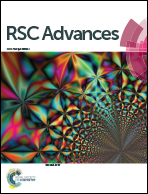Highly sensitive and rapid responding humidity sensors based on silver catalyzed Ag2S–TiO2 quantum dots prepared by SILAR
Abstract
We developed a resistive humidity sensor based on a heterojunction of silver sulfide (Ag2S) quantum dots (QDs) and TiO2 because of its specificity to water vapor adsorption and its insensitivity to environmental gases. The QDs were grown on a mesoporous TiO2 layer using the successive ionic layer adsorption and reaction (SILAR) method. The boundary condition between TiO2 and Ag2S provides a tunable energy gap by adjusting the number of SILAR cycles. Besides, the large surface-to-volume ratio of QDs provides a strong water vapor adsorption ability and electron transfer. Nano-silver precipitated during the SILAR process provides free electrons and lowers the Fermi level to between n-type TiO2 and p-type Ag2S. The resistance response increased significantly to 4600 and the reaction equilibrium time decreased greatly to 7 seconds due to the presence of nano-silver. Finally, the Ag2S QDs possess a best sensing range of 13–90%. To sum up, Ag2S QDs are high sensitivity and selectivity humidity sensors.



 Please wait while we load your content...
Please wait while we load your content...